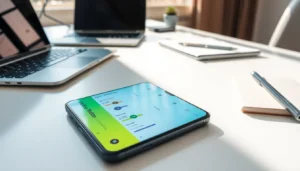In a world where smartphones have become an extension of our very selves, keeping tabs on screen time is more important than ever. Ever catch yourself wondering if you’ve spent more time scrolling through memes than actually living life? If so, you’re not alone. It’s time to take control and find out just how many hours you’ve dedicated to binge-watching cat videos or perfecting your TikTok dance moves.
Checking screen time on an Android device isn’t just about guilt-tripping yourself; it’s about understanding your habits and reclaiming precious minutes. With just a few taps, you can unveil the secrets of your digital life. So grab your phone, and let’s dive into the simple steps that’ll help you monitor your screen time and maybe even spark some much-needed balance in your day-to-day routine.
Table of Contents
ToggleUnderstanding Screen Time on Android
Monitoring screen time on Android devices plays a crucial role in managing digital habits. Knowing how much time is spent on apps helps users make informed choices about their usage.
Importance of Tracking Screen Time
Tracking screen time fosters awareness about daily habits. It highlights usage patterns and identifies excessive consumption, which can lead to digital fatigue. Recognizing time spent on different applications encourages users to create healthier digital boundaries. Users can amend behaviors that detract from productivity or relationships. Ultimately, tracking screen time aids in achieving a balanced lifestyle.
Overview of Android Screen Time Features
Android offers built-in features for tracking screen time effectively. The Digital Wellbeing app displays daily and weekly usage statistics for apps. Users can view how long they engage with particular applications, helping them spot trends in their usage. Options to set usage limits on apps provide additional control over screen time. Notifications alert users when limits are reached, promoting healthier consumption habits. Collectively, these features empower users to reclaim time spent on their devices.
How to Access Screen Time Settings on Android
Checking screen time on Android is a straightforward process. Users can navigate through various built-in features to monitor their digital habits effectively.
Using Digital Wellbeing App
To check screen time, the Digital Wellbeing app provides a comprehensive overview. Open the app from the app drawer or home screen. Upon opening, users see a dashboard displaying daily and weekly app usage statistics. This includes time spent on individual applications. Users can also set app limits and receive notifications when they’ve reached their usage caps. Accessing detailed use reports enables individuals to identify patterns in their screen time, promoting healthier digital habits.
Accessing Through Device Settings
Accessing screen time settings through device settings is another efficient method. Begin by opening the Settings app on the Android device. Within the settings menu, users should scroll to the “Digital Wellbeing & Parental Controls” section. They can then find screen time statistics similar to what the Digital Wellbeing app offers. Tapping on individual apps reveals precise usage data, along with options to manage notifications. This approach gives users a clear understanding of their smartphone habits and supports balanced usage.
Checking Your Screen Time
Monitoring screen time enhances awareness of app usage and overall digital habits. Users can easily track their daily engagements on Android devices.
Reviewing Daily Usage
Daily usage statistics provide insights into smartphone habits. Access the Digital Wellbeing app for an overview of daily app interactions. This displays total screen time alongside time spent on individual applications. Additionally, users can view weekly summaries to compare daily patterns. Insights from this data help in recognizing trends, such as peak usage times or those moments when distractions frequently occur. Adjusting screen time based on this information fosters healthier digital habits and enhances productivity. Users should regularly check these statistics for ongoing improvement.
Analyzing App-Specific Screen Time
App-specific screen time details individual app usage. Within the Digital Wellbeing app, users can view how long they engage with each application throughout the day or week. This feature highlights apps that consume excessive attention, which may lead to digital fatigue. Notifications remind users when they exceed predefined limits for specific applications. Customizing limits for individual apps promotes balanced usage and accountability. Awareness of app-specific consumption empowers users to make informed choices about their digital interactions, ultimately guiding them toward healthier behaviors.
Setting Screen Time Limits
Setting screen time limits helps users manage their digital habits effectively. Android provides several features to configure these limits.
Configuring App Timers
Users can set app timers to limit usage on specific applications. Opening the Digital Wellbeing app, they can tap on “Dashboard.” From there, selecting an app displays the option to set a timer. The timers can range from 5 minutes to 23 hours, ensuring flexibility. Once time is up, the app will grey out, preventing further use until the next day. These configurations allow individuals to allocate time wisely while promoting healthier engagement.
Utilizing Focus Mode
Focus Mode enables users to minimize distractions during critical tasks. Activating this feature requires accessing the Digital Wellbeing app and selecting “Focus Mode.” Once users choose the apps they want to pause, distractions fade away. This mode encourages concentration by silencing notifications from selected applications. Users can effortlessly schedule Focus Mode for regular intervals, enhancing productivity and mindfulness during work or study sessions. Balancing device usage becomes simpler with these proactive steps.
Monitoring screen time on Android devices is essential for fostering healthier digital habits. By utilizing tools like the Digital Wellbeing app users can gain valuable insights into their app usage and establish boundaries that promote balance. Setting screen time limits and activating Focus Mode are effective strategies for minimizing distractions and enhancing productivity.
This awareness not only helps in managing time better but also encourages users to reclaim moments that might otherwise be lost in endless scrolling. Embracing these practices leads to a more mindful interaction with technology allowing individuals to prioritize what truly matters in their lives.

